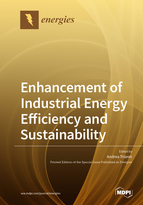Enhancement of Industrial Energy Efficiency and Sustainability
A special issue of Energies (ISSN 1996-1073). This special issue belongs to the section "B: Energy and Environment".
Deadline for manuscript submissions: closed (30 September 2020) | Viewed by 42398
Special Issue Editor
Interests: operations efficiency; industrial energy efficiency; industrial sustainability; industrial eco-efficiency; sustainable supply chain management
Special Issues, Collections and Topics in MDPI journals
Special Issue Information
Dear Colleagues,
Industrial energy efficiency has been recognized as a major contributor, in the broader set of industrial resources, to improved sustainability and circular economy. Nevertheless, the uptake of energy efficiency measures and practices is still quite low, due to the existence of several barriers. Research has broadly discussed them, together with their drivers.
More recently, authors have highlighted the existence of several benefits, beyond mere energy savings, stemming from the adoption of such measures, for several stakeholders involved in the value chain of energy efficiency solutions. Nevertheless, a deep understanding of the relationships between the use of the energy resource and other resources in industry, together with the most important factors for the uptake of such measures—also in light of the implications on the industrial operations—is still lacking. However, such understanding could further stimulate the adoption of solutions for improved industrial energy efficiency and sustainability. Furthermore, discussion around the set of services that could be offered to industrial final users to improve the use of the energy resources, also in regard to other resources, is far from being mature, calling for enhanced scientific and multi-disciplinary knowledge.
Therefore, this Special Issues seeks to offer a contribution in the debate over the aforementioned issues through a unique blend of theoretical and empirical papers, inviting authors to provide the latest innovative developments, reviews, case studies, and/or surveys, as well as multidisciplinary studies.
Prof. Dr. Andrea Trianni
Guest Editor
Manuscript Submission Information
Manuscripts should be submitted online at www.mdpi.com by registering and logging in to this website. Once you are registered, click here to go to the submission form. Manuscripts can be submitted until the deadline. All submissions that pass pre-check are peer-reviewed. Accepted papers will be published continuously in the journal (as soon as accepted) and will be listed together on the special issue website. Research articles, review articles as well as short communications are invited. For planned papers, a title and short abstract (about 100 words) can be sent to the Editorial Office for announcement on this website.
Submitted manuscripts should not have been published previously, nor be under consideration for publication elsewhere (except conference proceedings papers). All manuscripts are thoroughly refereed through a single-blind peer-review process. A guide for authors and other relevant information for submission of manuscripts is available on the Instructions for Authors page. Energies is an international peer-reviewed open access semimonthly journal published by MDPI.
Please visit the Instructions for Authors page before submitting a manuscript. The Article Processing Charge (APC) for publication in this open access journal is 2600 CHF (Swiss Francs). Submitted papers should be well formatted and use good English. Authors may use MDPI's English editing service prior to publication or during author revisions.
Keywords
- industrial energy efficiency
- energy efficiency measures
- industrial sustainability
- energy efficiency services
- sustainable operations






